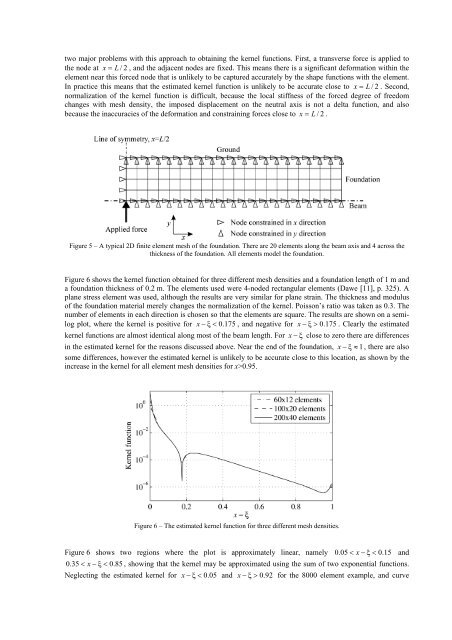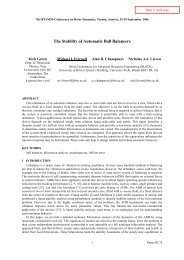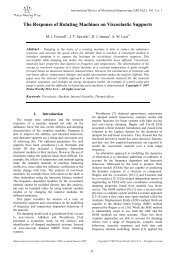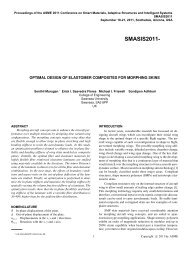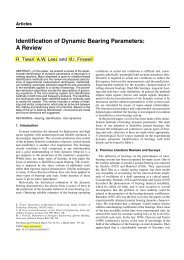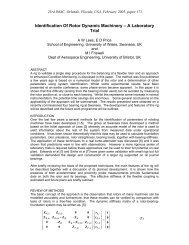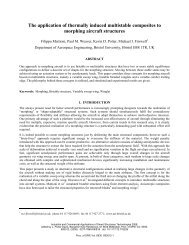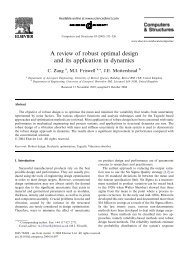Non-local Models of Stiffness and Damping - Michael I Friswell
Non-local Models of Stiffness and Damping - Michael I Friswell
Non-local Models of Stiffness and Damping - Michael I Friswell
You also want an ePaper? Increase the reach of your titles
YUMPU automatically turns print PDFs into web optimized ePapers that Google loves.
two major problems with this approach to obtaining the kernel functions. First, a transverse force is applied to<br />
the node at x = L /2, <strong>and</strong> the adjacent nodes are fixed. This means there is a significant deformation within the<br />
element near this forced node that is unlikely to be captured accurately by the shape functions with the element.<br />
In practice this means that the estimated kernel function is unlikely to be accurate close to x = L /2. Second,<br />
normalization <strong>of</strong> the kernel function is difficult, because the <strong>local</strong> stiffness <strong>of</strong> the forced degree <strong>of</strong> freedom<br />
changes with mesh density, the imposed displacement on the neutral axis is not a delta function, <strong>and</strong> also<br />
because the inaccuracies <strong>of</strong> the deformation <strong>and</strong> constraining forces close to x = L /2.<br />
Figure 5 – A typical 2D finite element mesh <strong>of</strong> the foundation. There are 20 elements along the beam axis <strong>and</strong> 4 across the<br />
thickness <strong>of</strong> the foundation. All elements model the foundation.<br />
Figure 6 shows the kernel function obtained for three different mesh densities <strong>and</strong> a foundation length <strong>of</strong> 1 m <strong>and</strong><br />
a foundation thickness <strong>of</strong> 0.2 m. The elements used were 4-noded rectangular elements (Dawe [11], p. 325). A<br />
plane stress element was used, although the results are very similar for plane strain. The thickness <strong>and</strong> modulus<br />
<strong>of</strong> the foundation material merely changes the normalization <strong>of</strong> the kernel. Poisson’s ratio was taken as 0.3. The<br />
number <strong>of</strong> elements in each direction is chosen so that the elements are square. The results are shown on a semilog<br />
plot, where the kernel is positive for x −ξ< 0.175 , <strong>and</strong> negative for x −ξ> 0.175 . Clearly the estimated<br />
kernel functions are almost identical along most <strong>of</strong> the beam length. For x −ξ close to zero there are differences<br />
in the estimated kernel for the reasons discussed above. Near the end <strong>of</strong> the foundation, x − ξ ≈ 1 , there are also<br />
some differences, however the estimated kernel is unlikely to be accurate close to this location, as shown by the<br />
increase in the kernel for all element mesh densities for x>0.95.<br />
Figure 6 – The estimated kernel function for three different mesh densities.<br />
Figure 6 shows two regions where the plot is approximately linear, namely 0.05 < x −ξ < 0.15 <strong>and</strong><br />
0.35 < x −ξ < 0.85 , showing that the kernel may be approximated using the sum <strong>of</strong> two exponential functions.<br />
Neglecting the estimated kernel for x − ξ < 0.05 <strong>and</strong> x −ξ> 0.92 for the 8000 element example, <strong>and</strong> curve


